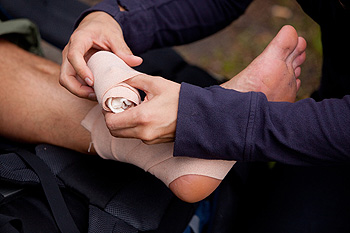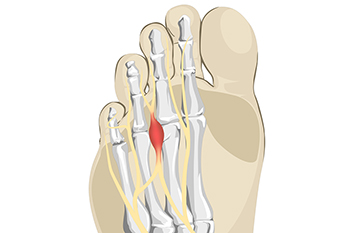Items filtered by date: February 2022
Do Your Child's Feet Hurt?
Signs to Go to a Podiatrist for Ankle Pain
 The ankle is composed of a variety of bones, ligaments, and tendons and is designed to allow the movement for the foot and support the body. Pain in the ankle can have a variety of causes that include sprained ankles, stress fractures, tarsal tunnel syndrome, arthritis, and Achilles tendonitis. Patients who are experiencing ankle pain should look for a few signs to determine if the care of a podiatrist is necessary. These signs include severe swelling, an open wound or deformity, signs of an infection, or the inability to bear weight. Less severe injuries may still need to be looked at by a podiatrist, if the swelling has been there for 2 to 5 days or the pain has not subsided after several weeks. A podiatrist will be able to properly diagnose the source of the pain as well as suggest the best course of treatment for the condition.
The ankle is composed of a variety of bones, ligaments, and tendons and is designed to allow the movement for the foot and support the body. Pain in the ankle can have a variety of causes that include sprained ankles, stress fractures, tarsal tunnel syndrome, arthritis, and Achilles tendonitis. Patients who are experiencing ankle pain should look for a few signs to determine if the care of a podiatrist is necessary. These signs include severe swelling, an open wound or deformity, signs of an infection, or the inability to bear weight. Less severe injuries may still need to be looked at by a podiatrist, if the swelling has been there for 2 to 5 days or the pain has not subsided after several weeks. A podiatrist will be able to properly diagnose the source of the pain as well as suggest the best course of treatment for the condition.
Ankle pain can have many different causes and the pain may potentially be serious. If you have ankle pain, consult with Edwin Oghoorian, DPM from Pacific Foot & Ankle Associates . Our doctor will assess your condition and provide you with quality foot and ankle treatment.
Ankle pain is any condition that causes pain in the ankle. Due to the fact that the ankle consists of tendons, muscles, bones, and ligaments, ankle pain can come from a number of different conditions.
Causes
The most common causes of ankle pain include:
- Types of arthritis (rheumatoid, osteoarthritis, and gout)
- Ankle sprains
- Broken ankles
- Achilles tendinitis
- Achilles tendon rupture
- Stress fractures
- Tarsal tunnel syndrome
- Plantar fasciitis
Symptoms
Symptoms of ankle injury vary based upon the condition. Pain may include general pain and discomfort, swelling, aching, redness, bruising, burning or stabbing sensations, and/or loss of sensation.
Diagnosis
Due to the wide variety of potential causes of ankle pain, podiatrists will utilize a number of different methods to properly diagnose ankle pain. This can include asking for personal and family medical histories and of any recent injuries. Further diagnosis may include sensation tests, a physical examination, and potentially x-rays or other imaging tests.
Treatment
Just as the range of causes varies widely, so do treatments. Some more common treatments are rest, ice packs, keeping pressure off the foot, orthotics and braces, medication for inflammation and pain, and surgery.
If you have any questions, please feel free to contact our office located in San Dimas, CA . We offer the newest diagnostic and treatment technologies for all your foot care needs.
Read more about Ankle Pain
The 1s, 2s, and 3s of Ankle Sprain Severity
When one or more ligaments in the ankle are overstretched or torn, an ankle sprain occurs. Ankle sprains can range from mild to severe. Podiatrists use a system of grading, or classification, to describe the severity of the sprain. A Grade 1 sprain is mild and characterized by mild pain, swelling, joint instability and stiffness, and difficulty jogging or jumping. A Grade 2 sprain is moderate and involves moderate pain, significant swelling, bruising, some loss of motion in the ankle, and trouble walking. A Grade 3 sprain, the most severe, is associated with severe pain, swelling, instability, loss of motion, and extreme difficulty walking. If you suspect that you may have sprained your ankle, please seek the care of a podiatrist.
Although ankle sprains are common, they aren’t always minor injuries. If you need your ankle injury looked at, contact Edwin Oghoorian, DPM from Pacific Foot & Ankle Associates . Our doctor can provide the care you need to keep you pain-free and on your feet.
How Does an Ankle Sprain Occur?
Ankle sprains are the result of a tear in the ligaments within the ankle. These injuries may happen when you make a rapid shifting movement while your foot is planted. A less common way to sprain your ankle is when your ankle rolls inward while your foot turns outward.
What Are the Symptoms?
- Pain at the sight of the tear
- Bruising/Swelling
- Ankle area is tender to touch
- In severe cases, may hear/feel something tear
- Skin discoloration
Preventing a Sprain
- Wearing appropriate shoes for the occasion
- Stretching before exercises and sports
- Knowing your limits
Treatment of a Sprain
In many cases, the RICE method (Rest, Ice, Compression, and Elevate) is used to treat ankle sprains. However, you should see a podiatrist to see which treatment option would work best with your injury. In severe cases, surgery may be required.
It is important to ask your doctor about rehab options after you receive treatment for your injury. Stretching, strength training, and balance exercises may help the ankle heal while also preventing further injury.
If you have any questions, please feel free to contact our office located in San Dimas, CA . We offer the newest diagnostic and treatment technologies for all your foot care needs.
Read more about Ankle SprainsWhat Can Be Done About Morton’s Neuroma?
If you experience a burning sensation and pain between the 3rd and 4th metatarsal bones in the foot, you may have developed a Morton’s neuroma. Though termed a neuroma, which means tumor, it is actually the thickening of the nerve that runs between the two bones and can cause a numbing of the toes above them. Many people also say it feels like there is a pebble in their shoe. This condition is more likely to occur in women and in people between 40 and 50 years old. It is most common in those who have worn high heels or very tight shoes over many years, including ballet dancers and runners. Non-surgical treatments include changing to wider footwear with lower heels and more cushioning and wearing inserts in your shoes. If the pain continues or gets worse, it is wise to consult a podiatrist who will examine your foot and explain other treatment options. Included are injections to numb the area or reduce the pain, custom orthotics and, in some cases, surgery.
Morton’s neuroma is a very uncomfortable condition to live with. If you think you have Morton’s neuroma, contact Edwin Oghoorian, DPM of Pacific Foot & Ankle Associates . Our doctor will attend to all of your foot care needs and answer any of your related questions.
Morton’s Neuroma
Morton's neuroma is a painful foot condition that commonly affects the areas between the second and third or third and fourth toe, although other areas of the foot are also susceptible. Morton’s neuroma is caused by an inflamed nerve in the foot that is being squeezed and aggravated by surrounding bones.
What Increases the Chances of Having Morton’s Neuroma?
- Ill-fitting high heels or shoes that add pressure to the toe or foot
- Jogging, running or any sport that involves constant impact to the foot
- Flat feet, bunions, and any other foot deformities
Morton’s neuroma is a very treatable condition. Orthotics and shoe inserts can often be used to alleviate the pain on the forefront of the feet. In more severe cases, corticosteroids can also be prescribed. In order to figure out the best treatment for your neuroma, it’s recommended to seek the care of a podiatrist who can diagnose your condition and provide different treatment options.
If you have any questions, please feel free to contact our office located in San Dimas, CA . We offer the newest diagnostic and treatment technologies for all your foot care needs.
Read more about What is Morton's Neuroma?What to Do if You Break a Toe
 A broken toe usually involves something heavy dropping on it or stubbing it on a piece of furniture or another hard surface. The result is bruising and swelling that makes it difficult or impossible to wear shoes due to the pain. Frequently, the patient walks with a limp if they can walk at all. It can take up to 6 weeks for a broken toe to fully heal. Here are a few measures you can implement at home to help with the healing process. First, stay off the foot, and then wrap it to keep the swelling down. Keep ice on the affected toe and elevate it as often as possible. You also may need to take over-the-counter pain medication. Whether your toe is broken or sprained, it is a good idea to consult a podiatrist who can determine the severity of the injury. The foot specialist will take an X-ray and depending on the results, wrap the injured toe to toe next to it (known as buddy taping) as a splint for stabilization. A hard boot may be prescribed to keep the toe safe from further injury. Walking aids, such as crutches, may also be recommended to help keep weight off the toe. In severe cases, surgery may be required.
A broken toe usually involves something heavy dropping on it or stubbing it on a piece of furniture or another hard surface. The result is bruising and swelling that makes it difficult or impossible to wear shoes due to the pain. Frequently, the patient walks with a limp if they can walk at all. It can take up to 6 weeks for a broken toe to fully heal. Here are a few measures you can implement at home to help with the healing process. First, stay off the foot, and then wrap it to keep the swelling down. Keep ice on the affected toe and elevate it as often as possible. You also may need to take over-the-counter pain medication. Whether your toe is broken or sprained, it is a good idea to consult a podiatrist who can determine the severity of the injury. The foot specialist will take an X-ray and depending on the results, wrap the injured toe to toe next to it (known as buddy taping) as a splint for stabilization. A hard boot may be prescribed to keep the toe safe from further injury. Walking aids, such as crutches, may also be recommended to help keep weight off the toe. In severe cases, surgery may be required.
A broken toe can be very painful and lead to complications if not properly fixed. If you have any concerns about your feet, contact Edwin Oghoorian, DPM from Pacific Foot & Ankle Associates . Our doctor will treat your foot and ankle needs.
What to Know About a Broken Toe
Although most people try to avoid foot trauma such as banging, stubbing, or dropping heavy objects on their feet, the unfortunate fact is that it is a common occurrence. Given the fact that toes are positioned in front of the feet, they typically sustain the brunt of such trauma. When trauma occurs to a toe, the result can be a painful break (fracture).
Symptoms of a Broken Toe
- Throbbing pain
- Swelling
- Bruising on the skin and toenail
- The inability to move the toe
- Toe appears crooked or disfigured
- Tingling or numbness in the toe
Generally, it is best to stay off of the injured toe with the affected foot elevated.
Severe toe fractures may be treated with a splint, cast, and in some cases, minor surgery. Due to its position and the pressure it endures with daily activity, future complications can occur if the big toe is not properly treated.
If you have any questions please feel free to contact our office located in San Dimas, CA . We offer the newest diagnostic and treatment technologies for all your foot and ankle needs.
Read more about What to Know About a Broken Toe


